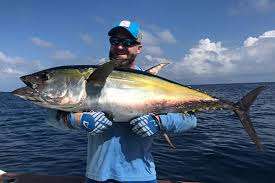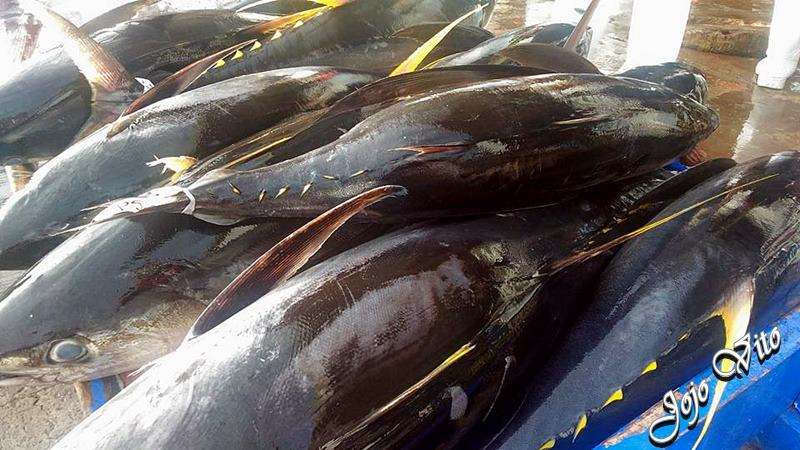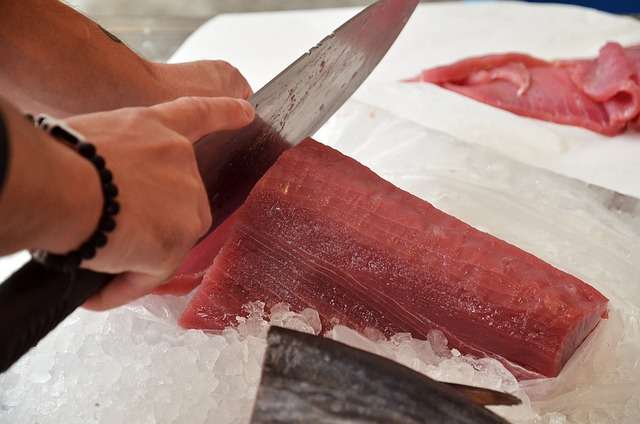
The story inextricably linked to ours. For centuries, these magnificent creatures have graced our plates, their flesh a prized delicacy. But our hunger has come at a cost. Unsustainable fishing practices have pushed some tuna populations to the brink of collapse, casting a shadow on the future of this remarkable species. However, this is not the end of the tale. The rising tide of awareness has spurred conservation efforts, and innovative fishing methods are giving tuna a fighting chance.
king of the jungle; crown the tuna Fish.
Born not as mighty warriors but as minuscule specks against an endless canvas of blue, hatchling begin their epic journey in the sun-dappled haven of coastal waters. Yet, within their tiny bodies burns an insatiable hunger and an unwavering instinct to roam the planet’s watery domain. Their saga unfolds across vast distances, each mile a testament to their unwavering spirit. Imagine them Traversing treacherous currents, weaving through hidden dangers, and outsmarting ravenous predators Each challenge encountered leaving an indelible mark, an inscription on the stone of their destiny.
Their transformation is as captivating as their odyssey. What begin as fragile specks, vulnerable to even the gentlest current, are sculpted by the relentless hand of evolution. Their bodies, initially translucent whispers in the water, morph into shimmering suits of mail, adorned with scales that reflect the sunlight, offering both camouflage and a dazzling display of defiance. These adaptations are not mere embellishments; they are the battle scars and survival strategies earned through countless encounters with life and death.
As they venture deeper, driven by an ever-growing ambition, their bodies are forged anew. Imagine these hatchlings, once adrift on the whims of the tides, evolving into torpedoes of pure muscle, propelled by hearts that pump with the unyielding rhythm of the ocean. This insatiable hunger fuels their transformation, each ounce of flesh honed for speed and endurance. Their fins, once delicate appendages, become propellers slicing through the water with unmatched efficiency, leaving competitors in their wake.
But survival in the vast, boundless ocean demands more than just brute strength. It requires cunning, an intelligence honed by millions of years of evolution. Imagine these creatures evolving senses that rival the most sophisticated technology. Their vision pierces the inky depths, detecting the faintest bioluminescent flicker of prey. Electrical signals ripple through the water, carrying messages only they can decipher, leading them to hidden bounties. Their bodies become living thermometers, defying the frigid embrace of the depths, allowing them to explore uncharted territories where others would perish.

As we contemplate the future we see reflected our own struggle for survival in a world grappling with change. Their remarkable resilience offers a beacon of hope, reminding us that even in the face of adversity, adaptation and collective action can pave the path towards a brighter future. By learning from the tuna’s story, we can harness the power of collaboration and innovation to ensure a healthy ocean and a sustainable future for ourselves and all its inhabitants.
Their first steps, or rather, fins, are tentative. Mere specks amidst the coastal tapestry, they navigate treacherous currents and evade ravenous predators, each encounter shaping them into lean, resilient survivors. But the true transformation unfolds as they answer the call of the open ocean, embarking on migrations that dwarf human expeditions. Driven by an internal compass and guided by the whispers of the sea, they traverse thousands of miles, their bodies constantly adapting to the ever-changing environment.

This delicious wasn’t limited to the Mediterranean. From the 18th and 19th centuries onwards, it became a key part of diets in Japan and Pacific Islands, highlighting its global presence.
At first, they mainly used albacore tuna, but soon faced shortages. This forced fishermen to explore new waters, mirroring the restless nature of itself, constantly roaming vast oceans.
Today, fishing methods have changed a lot, but concerns about sustainability are real. With millions of tons caught every year, ensuring the future of this tasty fish requires careful management and responsible practices.
Modern methods, though far more advanced than their ancestors, aren’t a magic bullet. The sheer scale of fishing raises questions about its impact populations and the wider marine ecosystem. Imagine vast nets sweeping up entire schools, not just the targeted catch, leading to unintended bycatch and potential harm to endangered species. The very mobility constantly roaming vast oceans, presents another challenge. Effective management across international borders becomes crucial to prevent overfishing and ensure healthy populations persist.

Thankfully, hope isn’t lost. Sustainable practices are emerging, offering rays of sunshine amidst the shadows. Techniques like pole-and-line fishing, where anglers meticulously target specific minimize bycatch and ensure a more responsible harvest. Marine protected areas offer safe havens for spawn and replenish their populations. Additionally, responsible sourcing initiatives empower consumers to make informed choices, supporting fisheries committed to sustainable practices.
But the journey from vulnerable hatchling to ocean warrior is a marathon, not a sprint. It begins in the open ocean, a nursery teeming with potential prey and predators alike. Survival for these tiny hinges on agility and camouflage. Their bodies, initially translucent, blend seamlessly with the sun-dappled water, making them near invisible to hungry eyes. As they grow, their scales take on a metallic sheen, reflecting light and further blurring their presence. These early adaptations are crucial for navigating the perilous world of plankton and predators.
As they mature, the relentless drive for survival pushes them towards deeper waters, where food is abundant but competition is fierce. It’s here that the transformation truly takes hold. Their bodies morph into torpedoes of pure muscle, fueled by an insatiable appetite. hearts double in size, pumping oxygenated blood with remarkable efficiency to power their relentless pursuit. Every ounce of flesh is honed for speed and endurance, allowing them to chase down prey with relentless stamina. Even their vision adapts, evolving to pierce the dim light of the deep, ensuring no meal escapes their keen eyes.

Imagine muscles that ripple with the power of a cheetah, transforming the from dainty hatchlings into relentless hunters. Their sleek forms, honed by evolution’s chisel, slice through the water with minimal resistance, leaving competitors trailing in their wake. Fins that were once delicate appendages morph into propellers, churning the water with astonishing efficiency. Each adaptation is a testament to the relentless pursuit of survival and dominance.
But the transformation goes beyond the physical. Their senses become instruments of unparalleled precision. Imagine eyes that pierce the gloom, painting the underwater world in vivid detail. These are not mere cameras; they are microscopes, detecting minuscule changes in light and color, allowing them to hunt with laser-like focus. Yet, sight is just one weapon in their arsenal. Imagine ears that resonate with the ocean’s heartbeat, detecting the thrumming vibrations of distant prey and the predatory rumble of approaching danger.

This transformation isn’t just about raw power; it’s about intelligence and strategy. Imagine navigators guided not by maps or stars, but by the subtle whispers of the ocean’s temperature and salinity. These living compasses chart courses across vast expanses, leading them to bountiful feeding grounds and ensuring their return to breeding havens. It’s a testament to the intricate dance between instinct and adaptation that has cemented their reign as the undisputed rulers of the open ocean.
The reign of these oceanic royalty isn’t without its threats. Unsustainable fishing practices, like vast nets sweeping them up indiscriminately, act as harbingers of a bleak future, a stark contrast to their hard-earned crown. Imagine the scales on their once resplendent armor dulled by overexploitation, their journeys curtailed by dwindling populations. This grim scenario, however, is not etched in stone. The tale of the tuna, like their remarkable transformation, is not a fixed narrative.
A new chapter beckons, one penned by sustainable practices and unwavering marine conservation efforts. Imagine fishing methods evolving, respecting the delicate balance of the ecosystem. Picture nets designed with escape routes for non-target species, quotas established to ensure populations thrive, and marine protected areas offering sanctuaries for regeneration. With each responsible action, we rewrite the ending, ensuring future generations marvel at the awe-inspiring journey.

But survival in the boundless ocean demands more than brute force. It requires cunning, an intelligence etched by millions of years of evolution. Imagine these creatures evolving senses that rival the most sophisticated technology. Their vision pierces the inky depths, detecting the faintest bioluminescent flicker of prey. Electrical signals ripple through the water, carrying messages only they can decipher, leading them to hidden feasts. Their bodies become living thermometers, defying the frigid embrace of the depths, allowing them to explore uncharted territories where others would perish.

Their transformation goes beyond sculpted muscle and streamlined bodies. Dive deeper, and you’ll witness senses refined to an astonishing degree. Imagine their eyes, not just cameras, but microscopes, piercing the deep’s unending darkness to paint vibrant portraits of their underwater world. The slightest flicker, the most subtle shift in color – all captured, allowing them to track prey with unwavering focus. But sight is just one facet of their sensory mastery. Imagine their ears, attuned to the ocean’s very heartbeat, picking up the faintest rhythm of distant schools and the menacing rumble of approaching predators.
These aren’t passive instruments; they’re active interpreters. Imagine electrical signals rippling through the water, carrying messages only they can decipher, leading them to hidden bounties like underwater treasure maps. Their bodies become living thermometers, defying the frigid embrace of the depths, allowing them to explore uncharted territories where others would perish. This sensory symphony allows them to navigate treacherous currents, outsmart cunning predators, and thrive in an environment that constantly tests their limits.
Theirs is not just a story of physical prowess; it’s a testament to the relentless adaptability of life itself. Each refined sense, from microscopic vision to electrical reception, whispers a tale of survival in the ever-changing dance of the ocean. Yet, a storm brews on the horizon. Unsustainable fishing practices threaten to disrupt the delicate balance they’ve mastered.
You May Also Like:



